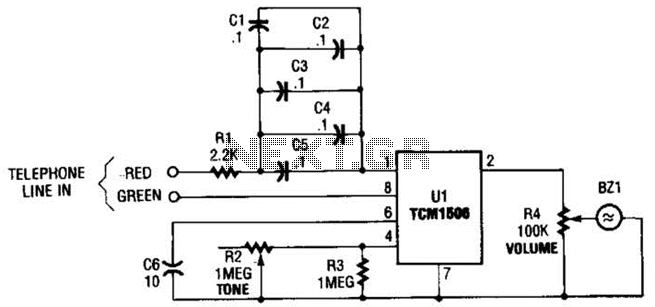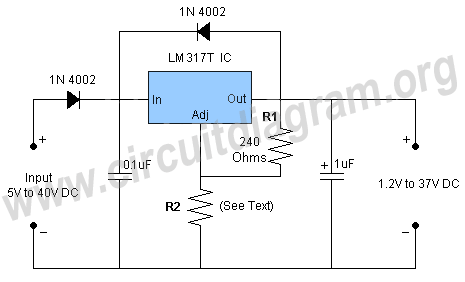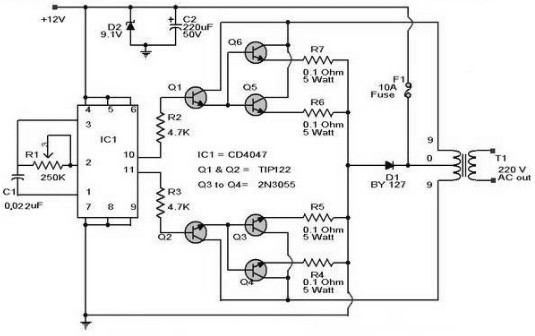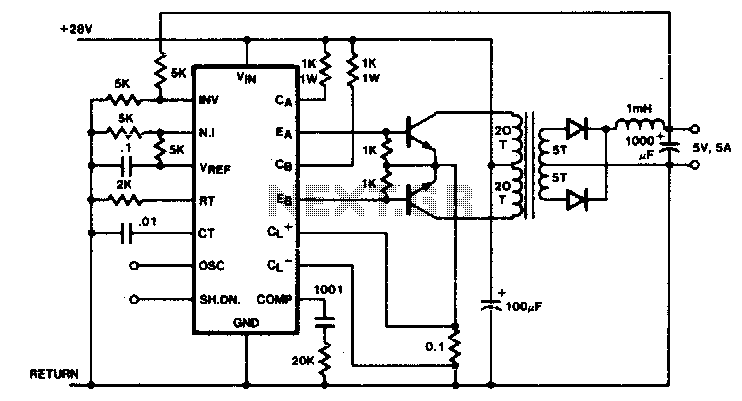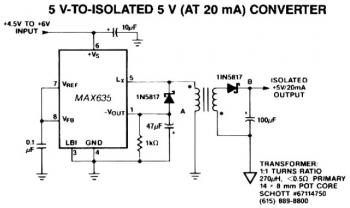
12 vdc to 220 vac converter circuits
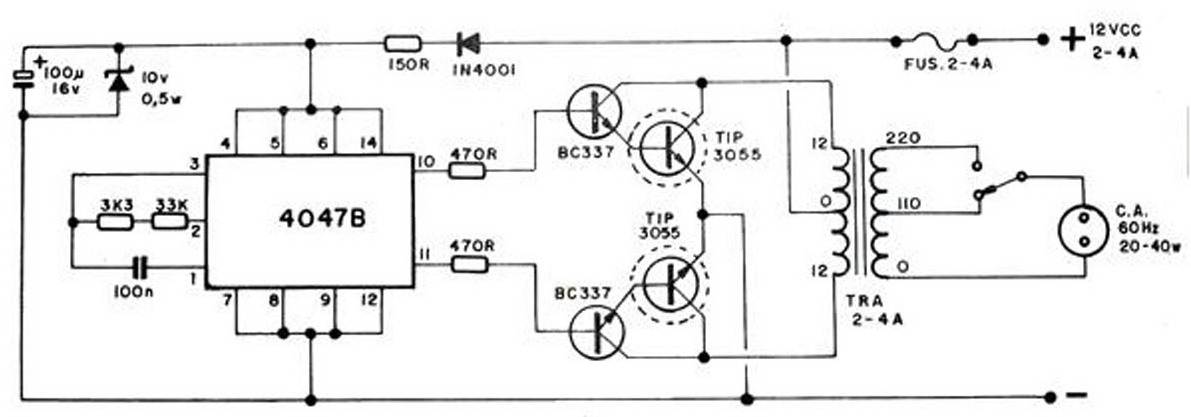
The converter transforms 12 VDC to 220 VAC, allowing for the conversion of 12 volts DC into 220 volts AC. The circuit diagram provided illustrates a simple converter circuit. This DC to AC converter can supply voltage for a 220V AC lamp during emergencies and can handle loads of up to 60 watts. The output from this DC to AC converter circuit is a square wave at 220 volts AC. The design incorporates a pulse generator from the astable multivibrator IC CD4047, a Darlington driver circuit using transistors BC337 and TIP3055, and a step-up transformer configured for 220 volts and 12 volts center-tap (CT). The converter can be powered by a 12-volt accumulator to produce a 220 volts AC output. A detailed schematic and component list for the 12V DC to AC converter circuit can be found in the accompanying figure. The circuit employs the CMOS IC CD4047 as a pulse generator, configured as an astable multivibrator. The astable multivibrator generates two outputs that are 180° out of phase. Each output drives the Darlington transistors BC337 and TIP3055, allowing for alternating operation, which drives the center-tapped transformer. The transformer’s secondary side is connected to the 12-volt terminals, while the primary side can be configured for either 220 volts or 110 volts output, depending on the load requirements.
The 12 VDC to 220 VAC converter circuit is designed to facilitate the conversion of direct current (DC) from a 12-volt source into alternating current (AC) at 220 volts, suitable for powering standard AC devices. The core of the circuit is the astable multivibrator configuration using the CD4047 IC, which generates a square wave signal. This signal alternates between high and low states, producing two outputs that are 180 degrees out of phase, effectively allowing for the control of the Darlington transistor pairs.
The Darlington pair configuration, consisting of BC337 and TIP3055 transistors, amplifies the current from the multivibrator to drive the transformer. The transformer is essential in stepping up the voltage from the lower 12 volts to the higher 220 volts required for AC output. The center-tap design of the transformer allows for flexible output options, enabling the circuit to be configured for either 220 volts or 110 volts, depending on the application needs.
The circuit can be powered from a 12-volt battery or accumulator, making it particularly useful in portable or emergency applications where conventional AC power sources are unavailable. The maximum load capacity of 60 watts indicates that the circuit is suitable for small appliances or lighting needs during power outages.
Overall, this converter circuit represents a practical solution for converting DC power to AC power, ensuring that essential devices can be powered in situations where traditional electrical sources are not accessible. The careful design of the pulse generation and amplification stages ensures reliability and efficiency in operation, making it a valuable tool for electronics applications.Converter 12 VDC to 220 VAC is a tool that can convert the DC voltage of 12 volts to 220 volts AC. Circuits converter 12 volt DC to 220V AC in the figure below is an example of a simple converter circuit. Dc to ac converter Circuits can be used to provide the source voltage at 220V AC lamp on emergency. DC to AC converter Circuits shown below can be given loads of up to 60 Watt. Output DC to AC converter circuit is 220 volts AC voltage square wave. DC to AC converter Circuits is built from power following a pulse from the astable multivibrator IC CD4047, darlington driver circuit transistor BC337 with TIP3055 then step-up converter is used as the primary transformer 220 volt and 12 volt CT. Converter Circuits can be supplied from an accumulator 12 volts to operate and provide 220 volts AC output voltage.
A complete circuit of components and a list of 12V DC to AC converter 220V in detail can be seen in the following figure. Converter Circuits was built using CMOS IC CD4047 as a pulse generator circuit. CD IC 4047 in DC to AC converter circuit above the set as an astable multivibrator. Astable multivibrator in the circuit output converter 12 volt DC to AC 220 volt output above there are two paths are mutually 180 ° out of phase.
The second output of each multivibrator is used to provide bias or triger to darlington transistor BC337 and TIP3055. With the difference multivibrator output pulses then the two pairs of Darlington transistors in the circuit of DC to AC converter will work on each in turn so that the transformers CT will receive two-way drive of the secondary side of transformers.
Converter using a transformer circuit output terminal CT with that used on the secondary side of the terminal 12 volt, 12 volt and CT. Then on the primary side can be selected as the output terminal 220 volt and 110 volt loads are supplied as required DC to AC converter circuit above.
🔗 External reference
The 12 VDC to 220 VAC converter circuit is designed to facilitate the conversion of direct current (DC) from a 12-volt source into alternating current (AC) at 220 volts, suitable for powering standard AC devices. The core of the circuit is the astable multivibrator configuration using the CD4047 IC, which generates a square wave signal. This signal alternates between high and low states, producing two outputs that are 180 degrees out of phase, effectively allowing for the control of the Darlington transistor pairs.
The Darlington pair configuration, consisting of BC337 and TIP3055 transistors, amplifies the current from the multivibrator to drive the transformer. The transformer is essential in stepping up the voltage from the lower 12 volts to the higher 220 volts required for AC output. The center-tap design of the transformer allows for flexible output options, enabling the circuit to be configured for either 220 volts or 110 volts, depending on the application needs.
The circuit can be powered from a 12-volt battery or accumulator, making it particularly useful in portable or emergency applications where conventional AC power sources are unavailable. The maximum load capacity of 60 watts indicates that the circuit is suitable for small appliances or lighting needs during power outages.
Overall, this converter circuit represents a practical solution for converting DC power to AC power, ensuring that essential devices can be powered in situations where traditional electrical sources are not accessible. The careful design of the pulse generation and amplification stages ensures reliability and efficiency in operation, making it a valuable tool for electronics applications.Converter 12 VDC to 220 VAC is a tool that can convert the DC voltage of 12 volts to 220 volts AC. Circuits converter 12 volt DC to 220V AC in the figure below is an example of a simple converter circuit. Dc to ac converter Circuits can be used to provide the source voltage at 220V AC lamp on emergency. DC to AC converter Circuits shown below can be given loads of up to 60 Watt. Output DC to AC converter circuit is 220 volts AC voltage square wave. DC to AC converter Circuits is built from power following a pulse from the astable multivibrator IC CD4047, darlington driver circuit transistor BC337 with TIP3055 then step-up converter is used as the primary transformer 220 volt and 12 volt CT. Converter Circuits can be supplied from an accumulator 12 volts to operate and provide 220 volts AC output voltage.
A complete circuit of components and a list of 12V DC to AC converter 220V in detail can be seen in the following figure. Converter Circuits was built using CMOS IC CD4047 as a pulse generator circuit. CD IC 4047 in DC to AC converter circuit above the set as an astable multivibrator. Astable multivibrator in the circuit output converter 12 volt DC to AC 220 volt output above there are two paths are mutually 180 ° out of phase.
The second output of each multivibrator is used to provide bias or triger to darlington transistor BC337 and TIP3055. With the difference multivibrator output pulses then the two pairs of Darlington transistors in the circuit of DC to AC converter will work on each in turn so that the transformers CT will receive two-way drive of the secondary side of transformers.
Converter using a transformer circuit output terminal CT with that used on the secondary side of the terminal 12 volt, 12 volt and CT. Then on the primary side can be selected as the output terminal 220 volt and 110 volt loads are supplied as required DC to AC converter circuit above.
🔗 External reference
